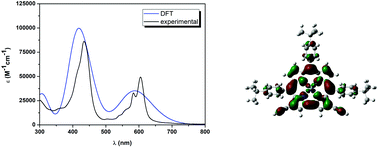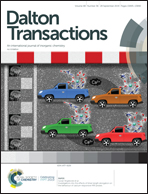β-Arylethynyl substituted silver corrole complexes†
Abstract
Silver corrolates are attractive compounds from both practical and theoretical points of view. Indeed, they play a key role in peripheral functionalization reactions occurring at the macrocycle, enabling high-yield and regioselective group insertions useful to further elaborate the molecular skeleton. In parallel, the Janus innocent or noninnocent behavior of the corrole ligand in these complexes makes their description particularly challenging. Herein, we report properties for a series of silver 3,17-disubstituted triarylcorrole complexes with various functionalities (halogens or different phenylethynyl units) that deeply affect the electron density in the macrocyclic ligand, with obvious repercussions on the observed spectral characteristics. The compounds were obtained in yields of 54–92% by applying the Stille coupling reaction with the appropriate tributylethynyl stannane. Among the complexes prepared was a derivative bearing two terminal acetylenic units which opens the way to “click” reactions for new corrole-based architectures. This corrole was structurally characterized by single crystal X-ray crystallography. The addition of substituted ethynyl groups resulted in red-shifts of the electronic absorption spectra, the largest of which was observed for the compound with two β-NO2–Ph–C![[triple bond, length as m-dash]](https://www.rsc.org/images/entities/char_e002.gif) C substituents. The remarkable influence of the NO2 groups on the electron density of this macrocycle was further demonstrated by electrochemical measurements, where an easier reduction of this complex derivative was observed as compared to the others. DFT calculations showed full delocalization over the entire p-nitrophenylethynyl unit of 5, largely affecting orbital distributions and the corresponding electronic absorptions. Although a variation of the β-substituents dramatically modifies the Soret- and Q-band positions towards lower energies for all the examined complexes, the saddling of the macrocycle resulting from functionalization is only moderate. The collected results suggest the description of these compounds as AgIII-corrolate3−, a metallocorrole with an innocent macrocyclic ligand.
C substituents. The remarkable influence of the NO2 groups on the electron density of this macrocycle was further demonstrated by electrochemical measurements, where an easier reduction of this complex derivative was observed as compared to the others. DFT calculations showed full delocalization over the entire p-nitrophenylethynyl unit of 5, largely affecting orbital distributions and the corresponding electronic absorptions. Although a variation of the β-substituents dramatically modifies the Soret- and Q-band positions towards lower energies for all the examined complexes, the saddling of the macrocycle resulting from functionalization is only moderate. The collected results suggest the description of these compounds as AgIII-corrolate3−, a metallocorrole with an innocent macrocyclic ligand.

- This article is part of the themed collection: Nitrogen Ligands


 Please wait while we load your content...
Please wait while we load your content...